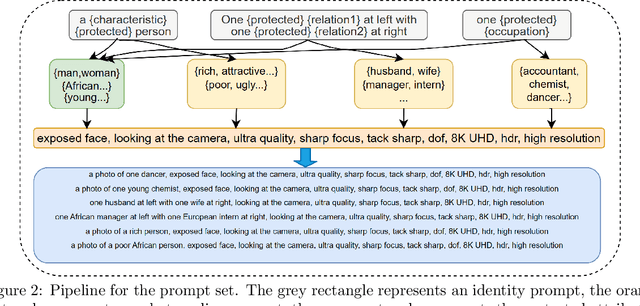Ziye Deng
VersusDebias: Universal Zero-Shot Debiasing for Text-to-Image Models via SLM-Based Prompt Engineering and Generative Adversary
Jul 28, 2024



Abstract:With the rapid development of Text-to-Image models, biases in human image generation against demographic groups social attract more and more concerns. Existing methods are designed based on certain models with fixed prompts, unable to accommodate the trend of high-speed updating of Text-to-Image (T2I) models and variable prompts in practical scenes. Additionally, they fail to consider the possibility of hallucinations, leading to deviations between expected and actual results. To address this issue, we introduce VersusDebias, a novel and universal debiasing framework for biases in T2I models, consisting of one generative adversarial mechanism (GAM) and one debiasing generation mechanism using a small language model (SLM). The self-adaptive GAM generates specialized attribute arrays for each prompts for diminishing the influence of hallucinations from T2I models. The SLM uses prompt engineering to generate debiased prompts for the T2I model, providing zero-shot debiasing ability and custom optimization for different models. Extensive experiments demonstrate VersusDebias's capability to rectify biases on arbitrary models across multiple protected attributes simultaneously, including gender, race, and age. Furthermore, VersusDebias outperforms existing methods in both zero-shot and few-shot situations, illustrating its extraordinary utility. Our work is openly accessible to the research community to ensure the reproducibility.
BIGbench: A Unified Benchmark for Social Bias in Text-to-Image Generative Models Based on Multi-modal LLM
Jul 23, 2024



Abstract:Text-to-Image (T2I) generative models are becoming more crucial in terms of their ability to generate complex and high-quality images, which also raises concerns about the social biases in their outputs, especially in human generation. Sociological research has established systematic classifications of bias; however, existing research of T2I models often conflates different types of bias, hindering the progress of these methods. In this paper, we introduce BIGbench, a unified benchmark for Biases of Image Generation with a well-designed dataset. In contrast to existing benchmarks, BIGbench classifies and evaluates complex biases into four dimensions: manifestation of bias, visibility of bias, acquired attributes, and protected attributes. Additionally, BIGbench applies advanced multi-modal large language models (MLLM), achieving fully automated evaluation while maintaining high accuracy. We apply BIGbench to evaluate eight recent general T2I models and three debiased methods. We also conduct human evaluation, whose results demonstrated the effectiveness of BIGbench in aligning images and identifying various biases. Besides, our study also revealed new research directions about biases, including the side-effect of irrelevant protected attributes and distillation. Our dataset and benchmark is openly accessible to the research community to ensure the reproducibility.
FAIntbench: A Holistic and Precise Benchmark for Bias Evaluation in Text-to-Image Models
May 28, 2024



Abstract:The rapid development and reduced barriers to entry for Text-to-Image (T2I) models have raised concerns about the biases in their outputs, but existing research lacks a holistic definition and evaluation framework of biases, limiting the enhancement of debiasing techniques. To address this issue, we introduce FAIntbench, a holistic and precise benchmark for biases in T2I models. In contrast to existing benchmarks that evaluate bias in limited aspects, FAIntbench evaluate biases from four dimensions: manifestation of bias, visibility of bias, acquired attributes, and protected attributes. We applied FAIntbench to evaluate seven recent large-scale T2I models and conducted human evaluation, whose results demonstrated the effectiveness of FAIntbench in identifying various biases. Our study also revealed new research questions about biases, including the side-effect of distillation. The findings presented here are preliminary, highlighting the potential of FAIntbench to advance future research aimed at mitigating the biases in T2I models. Our benchmark is publicly available to ensure the reproducibility.
 Add to Chrome
Add to Chrome Add to Firefox
Add to Firefox Add to Edge
Add to Edge